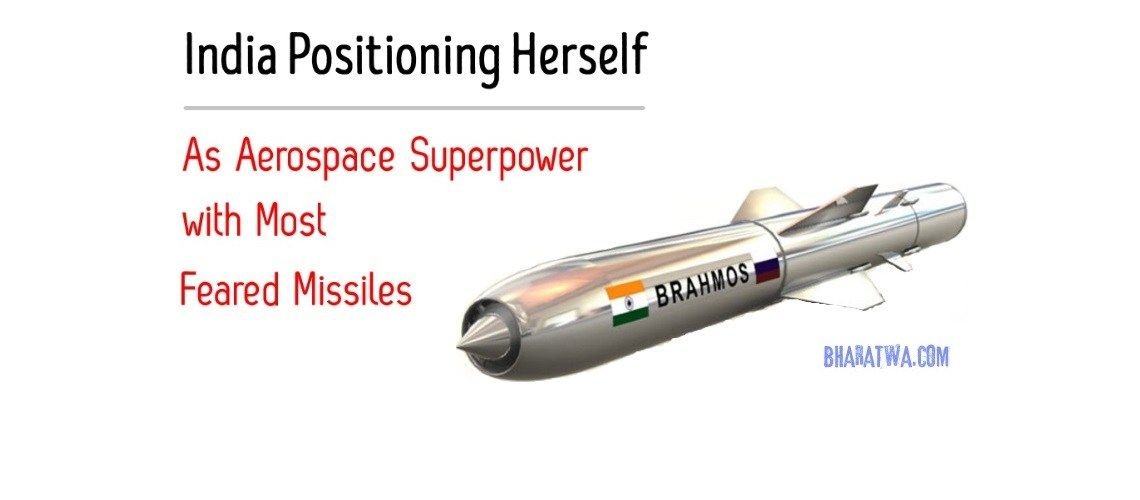India Positioning Herself As Aerospace Superpower with Most Feared and Unparalleled Missiles
Bharatwa Editor
. 7 min read
Recently when India tested world's no. 1 Supersonic Cruise Missile Brahmos with extended range from mobile autonomous launcher (MAL) then this was picked up by world as loud self declaration of mighty superpower and witnessed supremacy in aerospace;

India is Positioning herself as aerospace and military superpower with most feared Ballistic and Cruise Missiles, which world has no equal match. She is increasing its defense capabilities by having a strong indigenous defense industry, today in defense sector we are no less than any developed country, because we have built HAL Tejas, HAL LCH, Arjun MBT, Kolkata Class Destroyer, Aircraft Carrier INS Vikrant and ever expanding military without compromising quality.
Amid Third World War Whispers, India is Compelled to Develop Most Lethal Missile System
Today internet is flooded with the predictions of world war- 3 and those are not unreasonable, you can see uncertain alliances who further have conflict with rivals like - Russia has conflict with NATO, though all NATO countries are not totally against him, however still there are many disputed places where war can be triggered, there is inflexible world systems and superpowers like America, China or France may seek to undercut future rivals - US may sought to diminish China's ability who is challenging him openly in South China Sea or could try to blunt military power of North Korea who is test firing ballistic missile and challenging him repeatedly, Imbalanced Tandems like South and North Korea may finally break into war and such fight can galvanize sleeping giants which would try to crush their foes and lead world into third world war.
Also Read:
1. Why Is It Almost Impossible To Intercept A Nuclear Missile?
2. Top 5 Most Leathal Flying Weapons Ever Created In The World
There are many global conflicts which cannot be ignored like: Taiwan has all ingredients to turn into large conflict zone, conflict between Baltic States and Russia, conflict between India and twin alliance (China and Pakistan), Sweden is reportedly preparing hundreds of nuclear war shelters to protect citizens from radiations and shock waves because nuclear attack from Russia etc.
It should be noted that, for 67 Countries the U.S. Is obliged to Go to War and with Taiwan it has ambiguous defense agreement. To combat any war scenario, India Must make itself full proof by developing weapons; and missile technology is the field where India already has the upper hand and therefore it is easy to strengthen it.
Beside Nukes, when powerful nations including some developing countries are in continuous process of developing deadly weapons like:
The Tracking Point Rifle, Accuracy International AS50 Sniper Rifle, Smith & Wesson Revolver, Desert Eagle Pistol (DE50SRMMB), Heckler and Koch HK416 A5 Assault Rifle, drones, 5th generation fighter jets etc. then India cannot take the position of a mum, after all it has to provide safety to 1.25 billion citizens.
Present Capabilities of Indian Missile System
Being closer to Persian Gulf, Central Asia, Southeast Asia, India occupies one of the most geolocation in the world; although we have: AH-64D Apache Longbow Block III Attack Helicopter, INS Vikramaditya Aircraft Carrier, Su-30MKI Fighter jets etc. but still today’s defense system is considered deficient without advance missile system. India has almost reached the pinnacle of Missile Defence Capabilities with missiles as:
Indian Missile Defence Capabilities
Missile - Dhanush
- Targets - Variant of the surface-to-surface or ship-to-ship Prithvi III missile
- The capacity of Warheads (By weight) - 0.5 T
- In-Service
- Range - 350 km
Missile - K- 15 (aka B0-5)
- Targets - This is Submarine-launched ballistic missiles (SLBM) and can be fired from Sea to Sea
- The capacity of Warheads (By weight) - 500 kg
- In Service
- Range - 700 km
Missile - Shaurya (K-4)
- Targets - Surface to Surface Missile
- The capacity of Warheads (By weight) - 2.5 T
- In Service
- Range - 3500 km
Missile - Nag Anti-Tank Guided Missile
- Targets - Surface to Surface Missile
- The capacity of Warheads (By weight) - 8 kg
- In Service
- Range - 4 km
Missile - Nirbhay
Targets - Nirbhay is an all-weather, low-cost, long-range cruise missile and can be used for land, naval, air attacks
The capacity of Warheads (By weight) - 100 kg
In Production Stage
Range - 1000 km
Missile - Brahmos
- Targets - Land, Naval Air Attacks
- The capacity of Warheads (By weight) - 200 kg
- In Service
- Range - 300 km
Missile - Agni I
- Targets - It is a medium-range ballistic missile developed by DRDO and used for surface to surface assaults
- The capacity of Warheads (By weight) - 1 T
- In Service
- Range - 1250 km
Missile - Agni II
- Targets - Surface to surface
- The capacity of Warheads (By weight) - 1 T
- In Service
- Range - 3000 km
Missile - Agni III
- Targets - Surface to surface
- The capacity of Warheads (By weight) - 2.5 T
- In Service
- Range - 5000 km
Missile - Agni IV
- Targets - Surface to surface
- The capacity of Warheads (By weight) - 2 T
- In Service
- Range - 4000 km
Missile - Agni V
- Targets - Surface to surface
- The capacity of Warheads (By weight) - 1.5 T
- In Service
- Range - 8000 KMs
Missile - Prahaar
- Targets - Surface to surface
- The capacity of Warheads (By weight) - 200 kg
- In Service
- Range - 150 Km
Missile - Prithvi I
- Targets - Surface to surface
- The capacity of Warheads (By weight) - 1 T
- Not in service
- Range - 150 km
Missile - Prithvi II
- Targets - Surface to surface
- The capacity of Warheads (By weight) - 0.5 T
- In Service
- Range - 350 km
Missile - Prithvi III
- Targets - Surface to surface
- The capacity of Warheads (By weight) - 0.5T
- In Service
- Range - 600 km
Missile - Barak 8
- Targets - Indian-Israeli surface-to-air missile (SAM), it has capability to defend against aircraft, helicopters, anti-ship missiles, and UAVs or any other airborne threat.
- The capacity of Warheads (By weight) - 2.7 T
- In Service
- Range - 90 km
How Both the Ballistic and Cruise Missiles are very Important for India
Ballistic missiles differ with Cruise Missiles in the sense that they follow an arc-like trajectory and are launched from the land or sea and usually carry a nuclear warhead and are very heavy. Most Intercontinental Ballistic Missiles have the speed of 7 Km/sec.
On the other hand cruise missiles can be launched from air, those missiles have their own engine and wings, they fly through atmosphere of earth. These missiles are either supersonic or subsonic and hits target with great precision. Some conventional warheads can also be taken with cruise missiles, besides, greatest advantage of cruise missiles is their capability to carry nuclear weapons.
Also Read:
1. World War III- The Countdown of End of The World!
2. SpaceX Tests 27 Engined Gigantic Rocket First Time!
India is working to deploy a multi-layered ballistic missile defense system to combat any attack on its territory, advance interceptor missiles can intercept any incoming missile launched from 5000 Kilometers. India to also Continue With Indigenous Cruise Missile Program because through this she can target immediate threats.
Inter continental Ballistic Missiles in world have range from 5000 km to 16000 km whereas cruise missiles has maximum range of 2000 KMs, ICBM's are heavy missiles and can weight up to 30-35 tons whereas cruise missiles weights of 1500 Kg. Today ICBMs of India can cover most parts of China and whole Pakistan.
Top Nine Global Competitive Missiles which cannot be ignored while designing Indian missile defense strategies
- R- 36M2 - ICBM (Inter-Continental Ballistic Missile (Russia) is one of the most powerful missile and has range of approx. 10200 - 16,000 km. With a top speed 8 km/sec it has the capability of hitting target very precisely and can target multiple locations in single time.
- LGM-30 Minuteman range of 13,000 km, this has been developed by USA.
- DF-41 – ICBM with Range - 13000 Kms is one of the most lethal missile of China.
- M-51 Range having range of 8000 - 12000 Kms can reach the top speed of 8.5 kmps.
- UGM-133 Trident ll has the range of 12000 kms.
- Jericho lll range has the range of 2000- 11000 kms.
- Tomahawk having range of 2500 km and top speed of 0.24 kmps
- V-2 rocket has range 320 km.
- PGM-17 Thor with range 2820 km.
This is Why Brahmos Missile has no match in the World
Pakistan Successfully Tests 700km Range Babur Missile, But is no Match to Indian counterpart Brahmos Missile as there is no supersonic cruise missile not only in the kitty of Pakistan and china but rather in whole world with such range and accuracy. Brahmos missile is the missile with comparatively unique movement which it takes at the final leg of its flight.
- The Brahmos is an anti-ship supersonic cruise missile which can target the warships with great exactness.
- Brahmos is shorter ranged (290 KMs) but faster and more sophisticated. India is soon going to test extended range of BrahMos which will be able to hit target at 450 Kms.
- Western antiship missiles such as the Harpoon and Exocet have greater range, skims water, hard to track but are not supersonic like the Brahmos.
- Western Antiship missiles utilize the strategy of penetrating air defenses but BrahMos missile relies primarily on sheer speed and secondarily on built-in electronic countermeasures to penetrate a warship, fleets, air defense network, therefore is technically more advanced.
- Brahmos missile travels at speeds of Mach 2.8 to 3.0. 6. BRAHMOS is a unique missile which is two-stage missile with a solid propellant booster engine.
Also Read:
1. Imagining World War III Scenario Amidst Rising & Established Superpowers
2. Impact of China’s Aggression – America to Recalibrate Defence Alliances
Final Take
The Integrated Guided Missile Development Programme (IGMDP) was started in 1982-83 and was managed by Defence Research and Development Organisation (DRDO) and Ordnance Factories Board. At the time when Abdul Kalam joined, it was in its primitive state. It was his great vision, foresight and endeavors towards developing many missiles including Agni series, ballistic missiles, Prithvi Missiles, missiles which can target from surface to surface, air to air or water to air etc. which led India to present state.
No doubt that India has to complete its development mission of providing modern infrastructure, welfare services, rural amenities that any developed nation would need but meantime it must keep its momentum of developing defense capabilities especially missile technology to secure right seat on the world platform.
Only World Guru Bharata has the potential to lead the world in a way by which the character is formed, strength of mind is increased, the intellect is expanded on planet earth and rise of this Asian superpower will ensure that world will cherish and celebrate peace and will not disappear in suicidal wars, such is going to be the influence of my great country.
More Stories from
15 Pakistani Movies That Will Make you Forget Bollywood
We have compiled the ultimate list of top 15 Pakistani movies that you shouldn't miss, these left a greater social impact.
Film Mafia, Fueling the Fire and Enraging Masses
Film Mafia of Bollywood is Fictionalizing history, Rubbishing Religion, Promoting Anti-National Spirit, Mocking Hindu Gods, Award Wapsi and Intolerance drive
How did India respond to Donald Trump's 25% tariff penalty on India?
Trade tensions between the United States and India have sharply increased as a result of this recent development. Know how India responds to Donald Trump's 25% tariff penalty on India.
Geoffrey Hinton's AI Warning: The Most Dangerous Invention Ever
AI is both beneficial and dangerous, depending on how it is developed, deployed, and regulated.
Unbelievable Facts about World History that will surprise you
Human history and the natural world are filled with mysteries, marvels, and strange truths that challenge our understanding. In this article, we will explore some unbelievable facts about world history.





